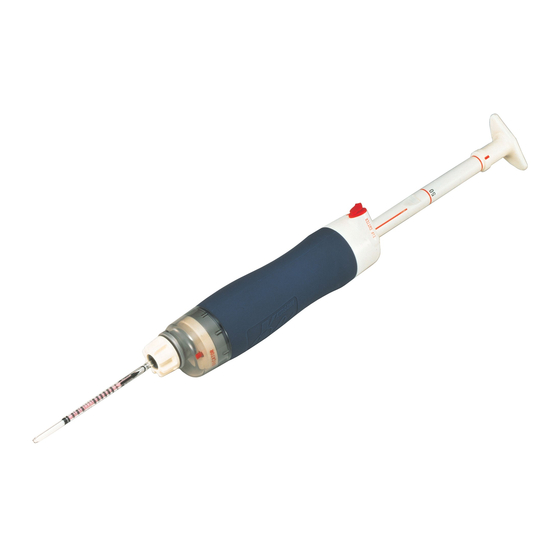Table of Contents
Advertisement
Advertisement
Table of Contents

Summary of Contents for Kitagawa AP-20
-
Page 2: For Safe And Correct Use
■ FOREWARD Thank you for purchasing the Model AP-20 sampling pump. The Model AP-20 pump is designed specifically for use with Kitagawa detector tubes. This system with the available Kitagawa detector tubes can detect the presence of more than 300 airborne gases and vapours. - Page 3 Any service or repair must be followed by a leak check prior to field use. !3 Note that the AP-20 pump is a vacuum pump only, and it cannot be used for specialized detector tubes that require sample entry by pressure (Oxygen, Hydrogen, Propane, etc.)
-
Page 4: Accessories Check List
Your kit should contain the follow ● ● ● ASPIRATING PUMP 1 pc. HAND STRAP 1 pc. GREA ● RUBBER CONNECT ■ AP-20 ASPIRATING PUMP COMPONENTS FLOW INDICATOR CONNECTOR HOLDER RUBBER TUBE CYLINDER CONNECTOR HEAD CASE ■ DETECTOR TUBE TYPICAL COMPONENTS... -
Page 5: Hand Strap
wing items. Verify that the accessories package is complete when unpacking. ● ASE (10g) 1 pc. INSTRUCTION MANUAL 1 copy ● CARRYING CASE 1 pc. TUBE TOR 2 pcs. HAND STRAP PISTON SHAFT HANDLE BOTTOM CASE TIP CUTTER SAMPLE VOLUME 100m/ TO RUBBER TUBE CONNECTOR... - Page 6 Note A leaking aspirating pump may cause lower readings or no response at all. Always conduct the following check before use. CHECKING PRIOR TO USE (Leakage Test) Insert a sealed, unbroken detector tube into the rubber tube connector. Align the red line on the bottom case and that of shaft, and pull the handle to full stroke locked position.
- Page 7 MAINTENANCE ● Application of new vacuum grease Pull the handle part way and turn the bottom case counterclockwise to remove it. Pull the piston out from the cylinder. Wipe off the old grease and dirt from the piston and inside the cylinder using a clean paper towel. Apply a thin coat of vacuum grease to the rubber gasket of the piston.
-
Page 8: Operating Procedure
■ OPERATING PROCEDURE Notes prior to use q The operating procedure varies from one detector tube to another. Before proceeding, read carefully the individual instruction sheets provided in each box. w Some detector tubes require temperature correction using tables provided in the instruction sheets. Be sure that the tube temperature has reached equilibrium with the sample area before drawing the sample. - Page 9 Connect the gas detector tube to the aspirating pump. The sample gas must be drawn through the gas detector tube in the correct direction. Insert the gas detector tube into the rubber tube connector with the tube's directional arrow pointing toward the pump.
- Page 10 ● 1. In case of faint discoloration Read the concentration of gas at the maximum end of the stain. DISCOLORED LAYER AP-20 side READING OUT POINT ● 2. In case that the end of the stain is slanted. Read out the numerical value at the middle of the oblique layer.
- Page 11 ■ TEMPERATURE CORRECTION PROCEDURE The temperature of concern is that of the detector tube (usually the temperature of the sample gas). IN CASE OF USE OF CORRECTION TABLE [EX.1] When the tube reading is 550 ppm at 25 degrees C, the true concentration is found by interpolating between the concentrations listed for 20 and 30 degrees C.
- Page 12 ■ MEASUREMENT & OPTIONS UNDER 1) Remote measurement A rubber extension hose (shown below) is used for remote detection of potentially harmful gases prior to entering a confined space such as a manhole or tank. The extension hose is placed between the detector tube and the aspirating pump to determine the gas concentration.
- Page 13 R THE SPECIAL CONDITIONS 3) High concentration gas measurement High concentration gas exceeding GAS SYRINGE the measuring range of the detector tube may be sampled as follows. Collect a volume of sample gas into a glass syringe and dilute with fresh air.
- Page 14 ■ DISPOSAL OF DETECTOR TUBES A detector tube contains a chemical reagent which reacts with the target gas. The chemical reagents used vary among different types of detector tubes, and may include substances regulated by laws for proper disposal. When discarding used detector tubes, dispose of them in accordance with local disposal regulations.
- Page 15 MEMO...
- Page 16 DISTRIBUTOR'S NAME : Air-Met Scientific Pty Ltd Distributed by: Air-Met Sales/Service Air-Met Rental P: 1800 000 744 P: 1300 137 067 F: 1800 000 774 E: hire@airmet.com.au Work with Confidence E: sales@airmet.com.au W: www.airmet.com.au Adelaide | Brisbane | Gladstone | Mackay | Melbourne | Perth | Sydney KOMYO RIKAGAKU KOGYO K.K.


Need help?
Do you have a question about the AP-20 and is the answer not in the manual?
Questions and answers